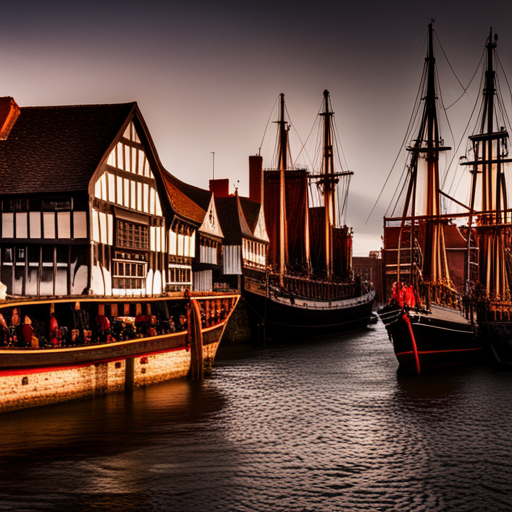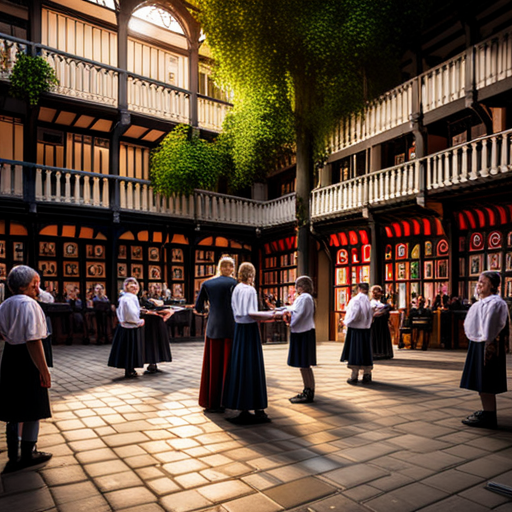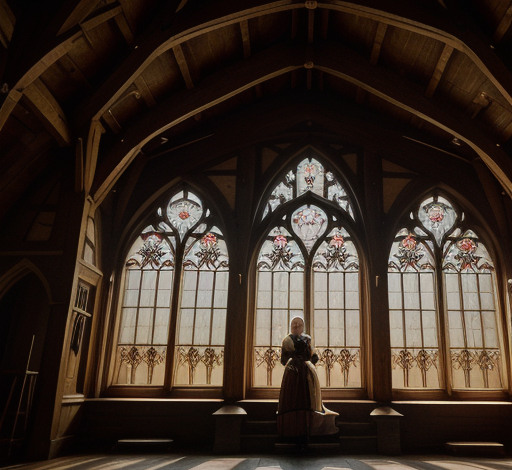
Tudor Southamptons Rich Cultural Tapestry
Discover the vibrant history of Tudor Southampton and immerse yourself in its rich cultural tapestry.
Step back in time as you explore this bustling port city, where trade routes thrived and connections were forged.
Witness the religious landscape during the Tudor era and delve into the flourishing arts scene that shaped Southampton’s identity.
Join us as we uncover the hidden gems and preserve the Tudor heritage that continues to captivate and inspire future generations.
The Rise of Southampton as a Tudor Port City

You can see how Southampton became a bustling port city during the Tudor era. The strategic location of Southampton, nestled on the south coast of England, made it an ideal hub for maritime trade. As England began to expand its global reach, Southampton played a pivotal role in facilitating trade with Europe and beyond.
The city’s natural harbor provided a safe haven for ships and attracted merchants from far and wide. With the support of the Tudor monarchs, Southampton flourished, establishing itself as one of the most important ports in England.
The influx of wealth and goods brought by trade transformed the city, leading to the growth of industries such as shipbuilding and cloth production. Today, you can still see remnants of this rich history in the city’s architecture and maritime heritage.
Exploring Southampton’s Trade Routes and Connections

Discover Southampton’s vibrant trade routes and connections, weaving together a diverse array of cultures and commodities.
As you delve deeper into the history of this bustling port city, you’ll uncover a fascinating tapestry of global trade.
Southampton’s strategic location on the south coast of England made it a key player in international commerce during the Tudor era. The city’s trade routes extended far and wide, connecting it to countries such as Spain, Portugal, France, and the Netherlands. Goods such as wine, wool, spices, and timber flowed through its busy harbor, enriching the local economy and attracting merchants from all corners of the world.
Southampton became a melting pot of different cultures, with foreign merchants settling in the city and adding to its vibrant cultural landscape.
Explore the remnants of this rich trading history as you wander through Southampton’s historic streets and imagine the hustle and bustle of its Tudor heyday.
Southampton’s Religious Landscape During the Tudor Era

Immerse yourself in the religious landscape of Southampton during the Tudor era and witness the diverse faiths that shaped the city’s identity.
Southampton, a bustling port city, was home to a variety of religious beliefs and practices. The dominant faith was Catholicism, with numerous churches and monasteries scattered throughout the city.
However, the religious landscape began to shift during the reign of Henry VIII, who broke away from the Catholic Church and established the Church of England. This led to the dissolution of monasteries and the suppression of Catholic worship.
Southampton became a hub for Protestantism, with the growing influence of the Church of England and the rise of dissenting Protestant groups.
The religious diversity of Southampton during the Tudor era reflects the broader religious changes taking place in England at the time.
The Flourishing Arts Scene in Tudor Southampton

Step into the vibrant arts scene of Southampton during the Tudor era and experience the flourishing creativity that defined the city’s cultural landscape.
In the 16th century, Southampton was a hub of artistic activity, attracting talented craftsmen, musicians, and writers. The city was home to an array of skilled painters who produced stunning portraits and landscapes. Southampton’s Tudor architecture also reflected the artistic flair of the era, with elaborately carved woodwork and decorative plaster ceilings adorning many buildings.
The city’s theaters and music halls buzzed with performances, showcasing the talents of local actors and musicians. Whether you were attending a play at the Dolphin Inn or admiring a beautiful tapestry at the Tudor House Museum, Southampton’s arts scene offered a vibrant and immersive experience that continues to captivate visitors to this day.
Preserving Southampton’s Tudor Heritage for Future Generations

Preserving Southampton’s Tudor heritage ensures future generations can appreciate and learn from the city’s rich artistic and architectural history.
As you explore the streets of Southampton, you’re transported back in time to the 16th century, where Tudor buildings proudly stand, displaying intricate timber frames and ornate carvings. These structures not only serve as a physical testament to the past but also provide valuable insights into the artistic and cultural life of the time.
By preserving these architectural gems, we can offer a glimpse into the Tudor era, allowing visitors to immerse themselves in the vibrant tapestry of Southampton’s history.
Through careful restoration and maintenance, we can ensure that future generations can continue to experience the beauty and significance of these Tudor treasures, fostering a deep appreciation for the city’s heritage.
Conclusion
In conclusion, Southampton’s rich cultural tapestry during the Tudor era is a captivating tale of trade, religion, and the arts.
As a thriving port city, Southampton played a crucial role in connecting England to the rest of the world.
Its religious landscape reflected the religious changes of the time, while its flourishing arts scene showcased the creativity and talent of its inhabitants.
Preserving Southampton’s Tudor heritage ensures that future generations can appreciate and learn from this fascinating period in history.



